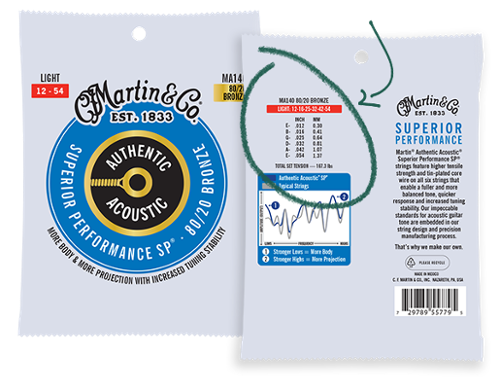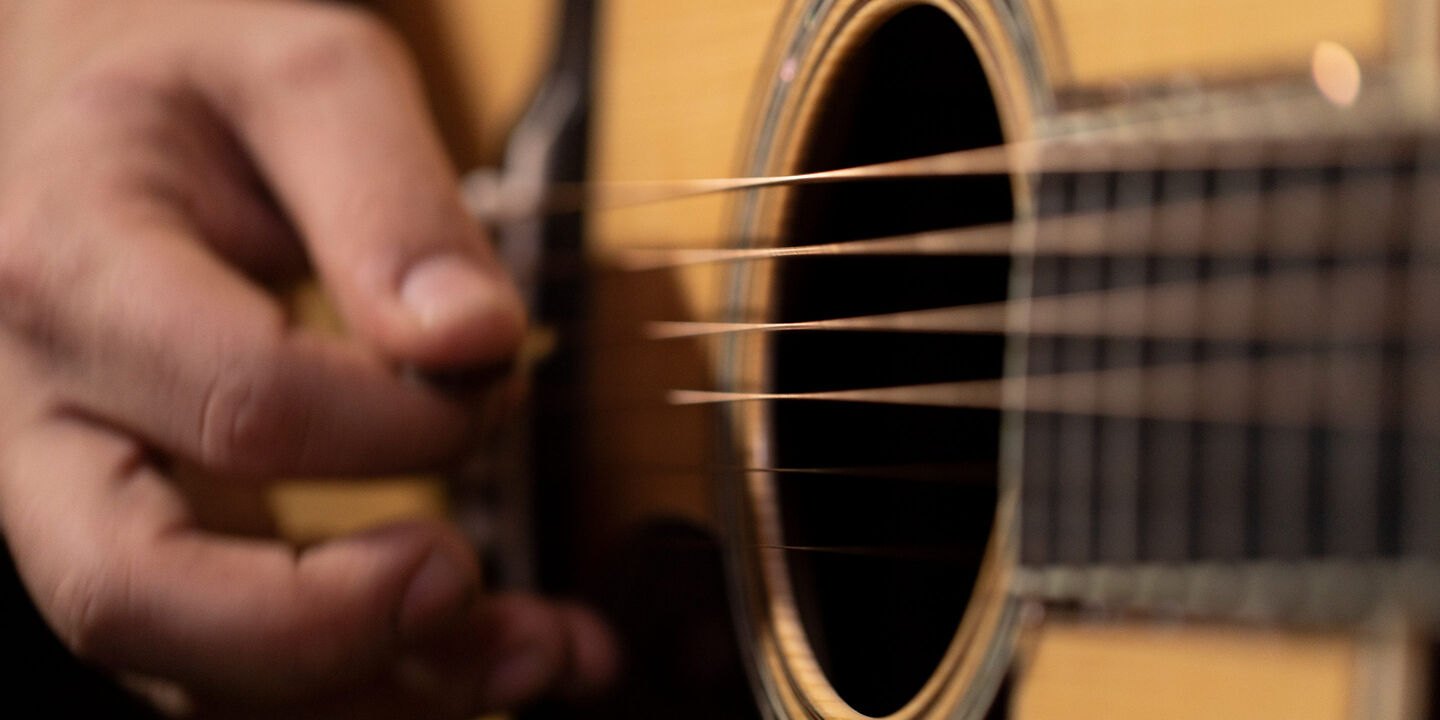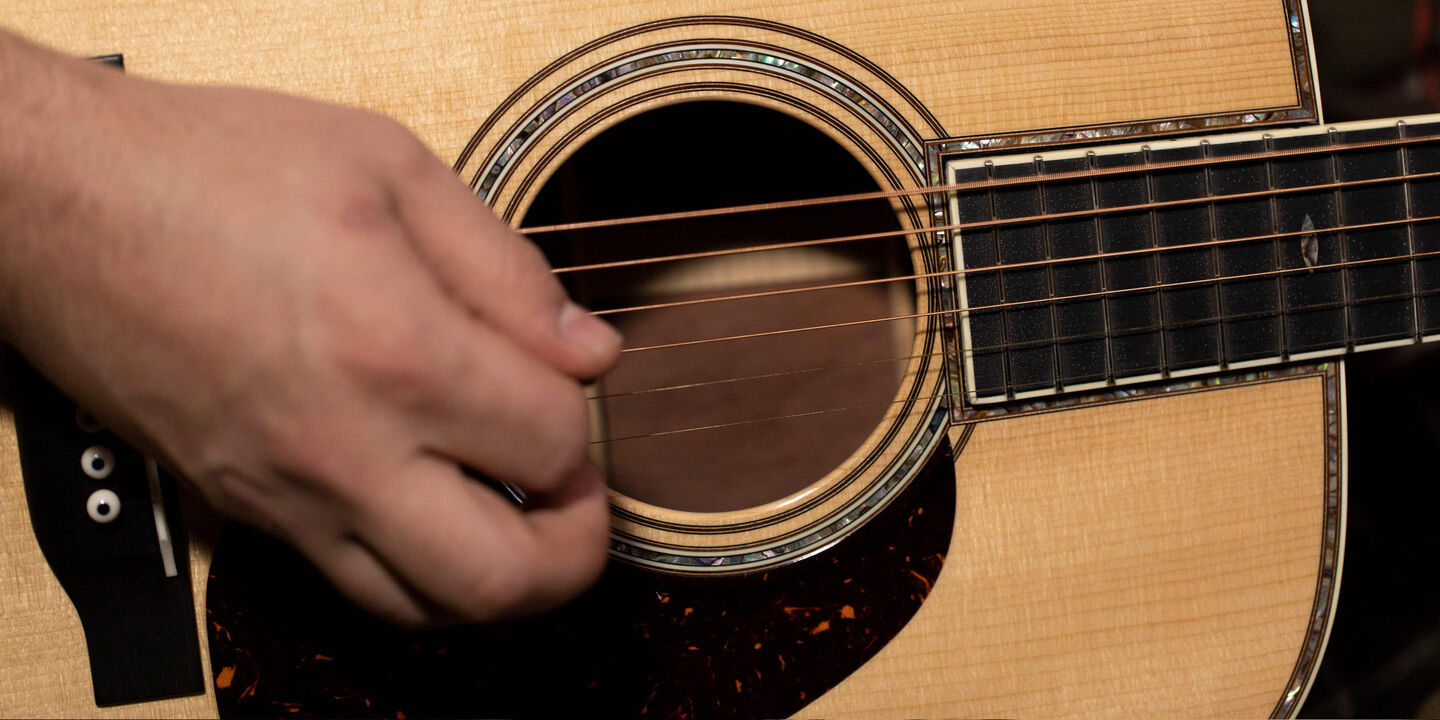How to Choose a String Gauge for your Acoustic Guitar
String gauge is an important part of playing and getting the best possible sound out of your guitar. Here’s everything you need to know about acoustic guitar string gauges to make an informed decision about what strings are best for you. We’ll cover string materials in a separate article.
What Is a String Gauge?
Gauge refers to the diameter of a string. Gauges are described in thousandths of an inch according to the high E string and can be found listed on the back of a string pack.

Overall, acoustic string gauges are classified as the following:
- Extra light
- Custom light
- Light
- Medium
- Heavy
For purposes of this article we’ll refer to anything from extra light to light as “lighter,” and anything from medium to heavy as “heavier.” While we want this article to be a comprehensive overview of string gauges for acoustic guitars, it is important to note that Martin does not recommend heavy gauge strings for any Martin guitars. We recommend using only extra light through medium gauge strings on our guitars. Heavy strings can cause too much tension on the top which may cause irreversible damage.
Pros and Cons of Acoustic Guitar String Gauges
What's the difference between light and medium guitar strings? How do heavy acoustic guitar strings differ from extra light ones? As you consider the best acoustic guitar string gauge for your needs, you need to understand more about each gauge's pros and cons. Here are factors you should know about:
- Lighter acoustic guitar strings: Lighter acoustic strings include extra light acoustic guitar strings, customer light acoustic guitar strings and light acoustic guitar strings. They are the lightest and easiest strings to play, making them a great choice for beginner guitarists. They have a wonderful, bright tone when played with a soft touch, and their low tension on the neck is good for short-scale acoustic guitars. They also have shorter life spans and have more difficulty holding their tune than heavier strings. Their low volume may make the guitar harder to hear when playing with other musicians.
- Medium acoustic guitar strings: Technically a part of the “heavier” string gauge category, these are the highest tension strings we recommend using on your Martin acoustic guitar. Regarding light vs. medium guitar strings, medium gauge provide a more balanced tone, greater midrange presence and longer life span. Medium guitar strings are still comfortable to play and exert healthy tension on various guitar sizes. Note that lighter guitar strings will capture more high tones than medium gauge guitar strings.
- Heavy acoustic guitar strings: Heavy acoustic guitar strings provide the best low tones, great tuning stability, high volume and increased durability. They generally have the longest life spans. These benefits come at the expense of being harder to play and exerting more tension on your acoustic guitar's neck. Heavy strings also lose some of the top-end sparkle from their tone.

How to Choose a String Gauge for Your Acoustic Guitar
When changing string gauge on acoustic guitar or picking out your first set of strings for a new instrument, you need to consider several factors.
What is your experience level?
If you’re just starting out, it’s not unusual that your fingers will have to toughen up a little. Lighter gauge strings will be more forgiving on your fingers as you’re learning, but as your dexterity and hand strength improve, you may find you prefer strings with different qualities.
Lighter strings
- Are easier to fret (important for beginners) and to bend.
- Have better resonance under a lighter touch, which is common when first starting out.
Heavier strings
- Have a bigger sound that provides more volume and resonance.
- Provide better tuning stability for staying in tune longer.
Consider the body size of your guitar.
While string gauge is very much a matter of personal preference based on tone and feel, most manufacturers recommend string gauge based on body size. This is primarily due to the amount of tension exerted on the guitar top by the strings. In general, the larger the body, the more tension it can withstand. Here's how lighter strings compare to heavier strings relating to guitar body size:
- Lighter: Lighter strings exert less tension and are typically recommended for smaller bodied guitars such as 0, 00, 000and OM, plus all cutaway models.
- Heavier: Heavier strings exert more tension and are typically recommended for larger body sizes such as D, Jumboand Grand Jumbo.

What style of music do you play?
Certain techniques and styles of playing will demand different attributes from your strings and can impact which gauge you should choose.
Lighter strings
- Are a good choice for rock, folk, country and blues styles playing with a lighter attack (plucking).
- Allow for easier bending of notes.
- May break more easily with more aggressive playing styles.
Heavier strings
- Are a good choice for bluegrass and genres that require tuning down.
- Are a good choice for rock, country, and blues style playing with a harder attack.
What sound are you going for?
Are you playing for yourself in your living room? Or do you need your sound to reach the back of an auditorium? You’ll want to be sure to choose the right string gauge that will help you and your guitar sound the best.
- Lighter: Lighter strings offer appropriate volume and range for playing in an intimate setting.
- Heavier: Heavier strings produce more volume and sustain. They're a great choice if you’re accompanied by other players.

What Happens if You Change String Gauge?
It's important to understand what happens to your guitar when changing to a lighter string gauge or heavier string gauge. Say you start with medium gauge guitar strings — going from medium to light gauge guitar strings will cause your guitar to experience less tension, resulting in the neck relaxing a bit, like a half-opened book opening further. This can lead to fret buzz as your strings might now contact certain frets along the fretboard due to the lower action caused by the relieved tension.
The opposite happens when changing to a heavier string gauge from a lighter one. The added tension causes the acoustic guitar's neck to bow inward, like a partially closed book. This will increase the action on your strings, increasing the difficulty of pressing strings on the frets to play notes. This can also cause severe damage to your acoustic guitar, especially if your instrument was designed for lighter-gauge strings.
It's wise to know the recommended tension for your acoustic guitar. If you're unsure, you can always contact the manufacturer, read any information included with your guitar or do some research online. Compare this information with the string gauges listed on the back of the packages of strings you're considering.
Here is a string gauge tuning chart to help you better understand your needs based on Martin Guitar's 80/20 bronze acoustic guitar strings:
- Extra light: E .010; B .014; G .023; D .030; A .039; E .047
- Custom light: E .011; B .015; G .023; D .032; A .042; E .052
- Light: E .012; B .016; G .025; D .032; A .042; E .054
- Medium: E .013; B .017; G .026; D .035; A .045; E .056
- Extra light 12-string: E .010/.010; B .014/.014; G .023/.010; D .030/.012; A .039/.018; E .047/.027
Experimenting with String Gauge
If you found yourself aligned with most of the qualities of “lighter” strings outlined here, choosing a string labeled “Light” is a good starting point. If you’re finding finger fatigue is an issue, or you wish it were easier to bend notes, try extra light or custom light gauge strings.
If most of the qualities of heavier strings appealed to you, start with strings that are labeled “Medium.” While Martin does not recommend using heavy gauge strings on Martin guitars, we want to paint a complete picture of string gauge options. Some guitarists use heavy gauge strings for amplification, sustain, drop/down tuning or tuning stability reasons.
One thing to keep in mind when trying out a new string gauge is to make sure your guitar is set up correctly for the gauge you're playing. Things like fret buzz can be a symptom of needing to visit a luthier to have your guitar adjusted.
Martin Strings — This Is Why We Make Our Own
Martin Guitar makes our own line of acoustic guitar strings in extra light through medium gauges from a variety of material options to suit every player. All of Martin’s guitars come strung with Martin strings, but they will give any brand of acoustic guitar the tone it deserves.
You can browse our complete line of strings here.
Other String Resources: